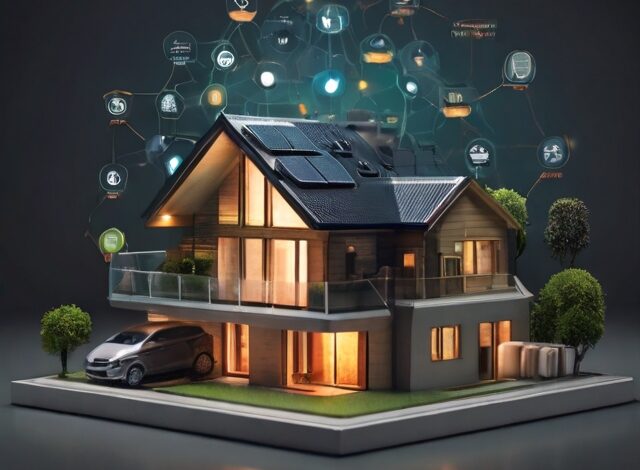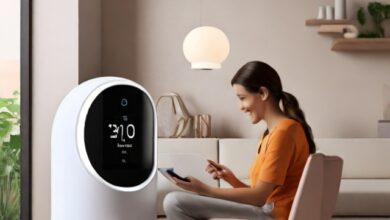How to create a smart home system with IoT devices

Introduction: Embracing the Future with Smart Home Systems and IoT Devices
Welcome to the age of the smart home, where convenience, efficiency, and security converge through the marvels of technology. The Internet of Things (IoT) has transformed ordinary houses into dynamic ecosystems, responsive to our needs and preferences. In this article, we’ll embark on an enlightening journey into the world of smart homes, powered by IoT devices, unraveling how they work, their benefits, and guiding you through the steps to create your own personalized smart home system.
The concept of a smart home, once a futuristic dream, is now a tangible reality. With IoT technology, everyday objects around us – from lights and thermostats to security cameras and speakers – can communicate with each other over the internet. This interconnectedness allows for a level of automation and control that was unimaginable just a few years ago. But what exactly does it mean to have a smart home? How do these devices integrate to create a cohesive, intelligent system?
Understanding IoT and Smart Home Technology
The Internet of Things (IoT): A Definition
The term “Internet of Things” (IoT) refers to the ever-growing network of physical objects that feature an IP address for internet connectivity, and the communication that occurs between these objects and other Internet-enabled devices and systems. IoT encompasses a wide range of devices, from simple sensors and smart bulbs to complex systems like smart home security systems. At its core, IoT is about connecting devices over the internet, letting them talk to us, applications, and each other.
IoT in Smart Homes: Communication and Integration
In the context of smart homes, IoT devices play a crucial role in automating and enhancing household functions. These devices are designed to be interconnected, enabling them to communicate with each other and work together to improve efficiency and user experience. For instance, a smart thermostat can learn your schedule and adjust the temperature automatically, while smart lights can be programmed to turn off when no one is in the room, saving energy and costs.
Evolution of Smart Home Technology
Smart home technology has evolved significantly over the years. Initially, home automation was limited to basic tasks and required substantial manual programming. However, advancements in IoT technology have transformed smart homes into highly sophisticated and user-friendly systems. Today, smart home devices not only perform individual tasks but can also learn from user habits and adapt accordingly. Voice assistants like Amazon’s Alexa, Google Assistant, and Apple’s Siri have further revolutionized control and interaction within the smart home, allowing for seamless integration of various devices.
Current Trends in Smart Home Technology
The current trends in smart home technology are driven by the integration of AI and machine learning, enhancing the capabilities of IoT devices. Voice control is becoming increasingly popular, enabling hands-free operation of home devices. There’s also a growing emphasis on security and privacy, with newer devices offering advanced encryption and secure connections to protect user data. Energy efficiency and sustainability are other key trends, with smart homes playing a significant role in reducing energy consumption through intelligent heating, cooling, and lighting systems.
IoT Device Communication Protocols
IoT devices in smart homes communicate through various protocols, including Wi-Fi, Bluetooth, Zigbee, and Z-Wave. Each protocol has its advantages and is suitable for different applications. For example, Wi-Fi is ideal for high-bandwidth applications like streaming, while Zigbee and Z-Wave are preferred for low-power sensors and devices.
Challenges and Considerations in IoT for Smart Homes
Despite the numerous benefits, there are challenges in implementing IoT in smart homes. Compatibility between different devices and platforms is a major concern, as not all devices communicate seamlessly with each other. Security is another critical issue, as IoT devices can be vulnerable to hacking and cyber-attacks. Users must ensure that their devices are regularly updated with the latest security patches. Privacy is also a significant consideration, as smart devices often collect personal data, which needs to be securely managed.
III. Planning Your Smart Home System
Assessing Needs and Goals
When planning a smart home system, the first step is to assess your specific needs and goals. Are you looking for enhanced security, energy efficiency, convenience, or a combination of these? Understanding what you want to achieve with your smart home is crucial in selecting the right devices. For instance, if security is a priority, focusing on smart locks, cameras, and alarm systems would be beneficial. On the other hand, if energy efficiency is the goal, smart thermostats and lighting would be more appropriate.
Budget Considerations
Budget plays a significant role in planning a smart home system. The cost of IoT devices can vary widely, so it’s important to set a realistic budget early on. It’s also worth considering the long-term savings that smart devices can offer, such as reduced energy bills through smart thermostats and lighting. Remember, you don’t have to purchase every device at once. Many people build their smart home system gradually, adding devices as their budget allows.
Choosing the Right Ecosystem
There are several ecosystems to choose from, such as Google Home, Amazon Alexa, and Apple HomeKit. Each ecosystem has its own set of compatible devices and unique features. For example, Google Home is known for its integration with Google services, while Amazon Alexa offers a vast range of skills that enhance its capabilities. Apple HomeKit emphasizes privacy and security, making it a strong contender for users concerned about data protection. Your choice of ecosystem will influence the types of devices you can integrate into your smart home system.
Compatibility and Scalability
When planning your smart home system, consider the compatibility of devices. Not all IoT devices work together seamlessly, so it’s important to check whether the devices you are interested in are compatible with your chosen ecosystem. Scalability is another key factor. As your needs change over time, you may want to add more devices to your system. Choose an ecosystem and devices that are scalable and can easily integrate new additions.
User Experience and Control The user experience is central to a smart home system. Consider how you want to interact with your devices – whether through voice commands, a mobile app, or automated settings. Some users prefer the convenience of voice control, while others might opt for more manual control through apps. Your lifestyle and preferences will dictate the best mode of interaction for your smart home system.
Security and Privacy
As smart home systems often handle sensitive data, security and privacy should be a top priority. Look for devices with strong security features, such as encryption and two-factor authentication. Regularly updating your devices and being aware of the data they collect and how it is used is also crucial in maintaining the privacy and security of your smart home system.
Conclusion
Planning a smart home system requires careful consideration of your goals, budget, and the ecosystem that best suits your needs. Paying attention to compatibility, scalability, user experience, and security will ensure that your smart home system not only meets your current needs but is also prepared for future advancements.
Frequently Asked Questions (FAQs) on Creating a Smart Home System with IoT Devices
1. What is the Internet of Things (IoT) and how does it relate to smart homes?
- IoT refers to the network of physical devices connected to the internet, enabling them to send and receive data. In smart homes, IoT devices can include thermostats, lights, locks, and more, which communicate with each other to automate and optimize home functions.
2. Do I need a strong internet connection for a smart home system?
- Yes, a stable and strong internet connection is crucial for the optimal functioning of IoT devices, especially for those that rely on cloud services for features like remote access and control.
3. Are smart home systems secure?
- Smart home systems can be secure, but it’s important to choose devices with robust security features and regularly update them. Using strong, unique passwords and considering additional security measures like firewalls can enhance security.
4. Can I integrate existing appliances into a smart home system?
- Yes, many existing appliances can be integrated into a smart home system using smart plugs or switches, which allow you to control them remotely.
5. How do I choose the right smart home ecosystem?
- Consider factors like compatibility with existing devices, desired features, and personal preference for user interfaces. Popular ecosystems include Google Home, Amazon Alexa, and Apple HomeKit.
6. How much does it cost to set up a smart home system?
- The cost varies widely depending on the scale and complexity of the system. Basic setups can start from a few hundred dollars, while more advanced systems can cost thousands.



